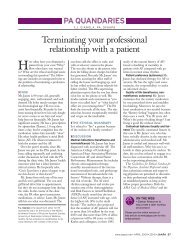Essential Guide to E-mail Marketing - Haymarket
Essential Guide to E-mail Marketing - Haymarket
Essential Guide to E-mail Marketing - Haymarket
Create successful ePaper yourself
Turn your PDF publications into a flip-book with our unique Google optimized e-Paper software.
30 INFRASTRUCTURE DM News • E-Mail <strong>Marketing</strong> <strong>Guide</strong> 2007<br />
Keep your e-<strong>mail</strong> safe from<br />
legal challenges<br />
BY ZAFAR KHAN<br />
If your company does business transactions via e-<strong>mail</strong>, you’ll<br />
need <strong>to</strong> be sure that business-critical messages are treated, well,<br />
critically. While most e-<strong>mail</strong> users are not concerned about the<br />
electronic record they have created, it can serve as a critically<br />
important defense for business transitions, if properly managed.<br />
Businesses must consider anti-spam laws, e-discovery rulings,<br />
s<strong>to</strong>rage and retention of e-<strong>mail</strong>s. Proof of e-<strong>mail</strong>s for business<br />
transactions are a must have, and companies are investing billions<br />
of dollars <strong>to</strong> protect themselves. Analysts at the Radicati Group<br />
estimate that the e-<strong>mail</strong> archiving market will hit $6 billion in<br />
2010.<br />
The good news is e-<strong>mail</strong> technology is catching up with the<br />
evolving regula<strong>to</strong>ry and business landscape. A case in point is<br />
Great Lakes List Management, an Erie, PA-based provider of data<br />
for direct marketers, and an RPost client. Because Great Lakes’<br />
business model involves multiple companies — including direct<br />
cus<strong>to</strong>mers and list brokers — it experiences a sizeable time lag<br />
between delivering services and getting paid for them. By sending<br />
business files with a registered e-<strong>mail</strong> service, Great Lakes receives<br />
a detailed electronic audit trail that proves precisely what e-<strong>mail</strong><br />
content and attachments were sent and received, by whom and<br />
when. Armed with this information, the company can ensure it<br />
gets paid for services rendered without hassle, and has the necessary<br />
backup <strong>to</strong> demonstrate compliance with regulated/required<br />
disclosures, such as privacy notices.<br />
For companies that operate their business using e-<strong>mail</strong>, legal protection<br />
is even more critical.<br />
Provisions of electronic law and<br />
recent court decisions underscore<br />
the fact that electronic business<br />
systems require proper transaction<br />
documentation, and a reliable<br />
recordkeeping management<br />
system.<br />
Here are a few ways you can<br />
ensure your business is safe from<br />
legal challenges:<br />
■ Send business-critical e-<strong>mail</strong>s<br />
Zafar Khan<br />
with legal proof of delivery and<br />
RPost<br />
content.<br />
■ Archive your e-<strong>mail</strong>s in a solution that’s easy <strong>to</strong> retrieve.<br />
■ Prevent e-<strong>mail</strong> manipulation on the receiving end with encryption<br />
<strong>to</strong>ols.<br />
■ Don’t save every single e-<strong>mail</strong>, just the business-critical ones.<br />
Many e-<strong>mail</strong> service providers aim <strong>to</strong> ensure deliverability and<br />
legally protect their e-<strong>mail</strong> users with value-added services, such as<br />
proof of delivery and content with registered e-<strong>mail</strong>, e-contracting<br />
<strong>to</strong>ols, encryption, meta data cleaning and e-<strong>mail</strong> archiving capabilities.<br />
Take advantage of the technology that is out there <strong>to</strong> cost<br />
effectively and proactively protect yourself.<br />
Zafar Khan is CEO and founder of RPost. You can reach him at<br />
zkhan@rpost.com.<br />
ESSENTIAL GUIDE<br />
Questions and answers<br />
about sending reputation<br />
BY GEORGE BILBREY<br />
Astudy by Return Path indicates that more than 80 percent of<br />
delivery problems are caused by reputation. But there is still<br />
confusion as <strong>to</strong> what reputation is, where the data comes from and<br />
how <strong>to</strong> manage your reputation for better deliverability. Below are<br />
three common questions that<br />
marketers ask about reputation.<br />
1. What is a sender reputation<br />
and how do ISPs and other e-<strong>mail</strong><br />
receivers moni<strong>to</strong>r it? Your sending<br />
reputation is made up of a<br />
variety of fac<strong>to</strong>rs, primarily complaint<br />
rates, unknown user rates,<br />
spam trap hits, infrastructure<br />
issues and sending stability.<br />
Spammers tend <strong>to</strong> do badly on<br />
these measures. Your job is <strong>to</strong> not<br />
George Bilbrey<br />
look like a spammer by perform-<br />
Return Path’s Sender Score<br />
ing well on these measures. Every<br />
major receiver has a slightly different way of determining and<br />
measuring reputation. They begin with their own data — what they<br />
see on their network. Some ISPs also use proprietary reputation<br />
data aggrega<strong>to</strong>rs <strong>to</strong> see how a sender behaves with other receivers.<br />
2. How can I manage my e-<strong>mail</strong> reputation <strong>to</strong> ensure high deliverability?<br />
It really comes down <strong>to</strong> the <strong>to</strong>p five fac<strong>to</strong>rs that are<br />
most likely <strong>to</strong> get you blocked. These are:<br />
■ Complaint rate: Isolating why your subscribers complain about<br />
you is crucial <strong>to</strong> bringing this number down. We find the following<br />
fac<strong>to</strong>rs <strong>to</strong> be the most common: Weak or no permission; content<br />
that isn’t valuable or relevant; <strong>to</strong>o high or low frequency; and<br />
subscribers’ inability <strong>to</strong> recognize the e-<strong>mail</strong>.<br />
■ Unknown user rate: If you have a high unknown user rate you<br />
need <strong>to</strong> review your bounce processing rules and make sure you<br />
are removing “unknown user” hard bounces after two attempts.<br />
■ Spam trap hits: You can see if you are hitting some spam traps<br />
through Microsoft’s Smart Network Data Services. Unfortunately,<br />
while this and other publicly available <strong>to</strong>ols can tell you if you have<br />
spam traps, there isn’t any way <strong>to</strong> identify which e-<strong>mail</strong> addresses<br />
they are. Instead, you need <strong>to</strong> isolate the parts of your list most<br />
likely <strong>to</strong> harbor spam traps and suppress those parts of the list.<br />
■ Infrastructure: There are specific ways that ISPs like <strong>to</strong> see a<br />
<strong>mail</strong>ing system set up in order <strong>to</strong> have some confidence that the<br />
e-<strong>mail</strong> is legitimate. If you use a reputable e-<strong>mail</strong> service provider,<br />
you shouldn’t have infrastructure issues. If you are sending your<br />
own messages, you should consider reaching out <strong>to</strong> a deliverability<br />
expert.<br />
■ Sending stability: Once you have established a good reputation<br />
for an IP address, don’t move <strong>to</strong> a new server.<br />
3. How can I determine my reputation? There are a number of<br />
public sources of reputation data. These include Microsoft’s<br />
SNDS, DNSStuff, CipherTrust’s TrustedSource, Ironport’s<br />
Senderbase, and Return Path’s Sender Score.<br />
George Bilbrey is vice president and general manager of Return Path’s Sender<br />
Score. You can reach him at george.bilbrey@returnpath.net.
















